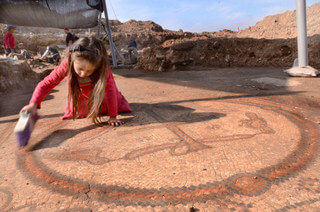As part of a salvage excavation by the Antiquities Authority prior to development works by the Israel Lands Authority to expand Moshav Aloma in the Shapir Regional Council, near the Pelugut junction * According to the archaeologists, "it seems that the church served as a center of Christian worship for the surrounding settlements"

Impressive archeological finds, including a 1500-year-old central church with a magnificent mosaic and five inscriptions, were uncovered as part of rescue excavations by the Antiquities Authority prior to development works by the Israel Lands Authority to expand Moshav Aloma in the Shapir Regional Council, near the Pilugut junction. The excavations were conducted by archaeologists Dr. Daniel Varga and Dr. Davida Dagan, and were funded by the Israel Lands Authority.
According to Dr. Daniel Varga, the director of the excavation on behalf of the Antiquities Authority: "An impressive basilica structure was discovered at the site, 22 m long and 12 m wide. The building is divided into a central hall and two side halls separated by marble columns. At the front of the building is a spacious open courtyard (atrium), paved with a white mosaic floor and a water cistern. From the courtyard you enter a transverse rectangular hall (narthex) paved with a fine mosaic floor decorated with colorful geometric patterns and in the center, in front of the entrance to the main hall, a dedication inscription in Greek with 12 lines, in which Mary and Jesus are mentioned, and the donor of the money for the construction of the mosaic."
The main hall (the middle hall), is paved with a colorful mosaic carpet decorated with grape vines forming 40 medallions. In the medallions there are descriptions of various animals including: zebra, tiger, giraffe, turtle, wild boar, chameleon, peacocks and various winged animals and floral decorations and geometric patterns. In three medallions were found dedicatory inscriptions in the Greek language in memory of senior officials who served in the church: Demetrius and Herakles. The two were the heads of the local and regional church. On both sides of the central hall there are a pair of other narrower halls (sitras), which are also paved with colorful mosaic carpets, with models from the world of Christian symbols, the world of plants and geometric decorations.
During the excavations, a pottery workshop was also excavated - mainly for jugs, and many findings were found including: amphorae, cooking pots, cauldrons, bowls and various oil candles. Glass vessels typical of the Byzantine period were also discovered at the site. These findings testify to a complex and rich culture in the place.
This church is part of a large and central Byzantine settlement that existed in the area. The settlement is located next to the main road that connected Ashkelon on the seashore in the west and Beit Govrin and Jerusalem in the east. Along the road, the excavations of the Antiquities Authority uncovered additional settlements from this period, in which no churches were found. The church now uncovered may have served as a center
The Israel Lands Authority, the Shapir Regional Council and the Antiquities Authority will open the site to the general public today Thursday afternoon and tomorrow Friday morning (23-24/1)
